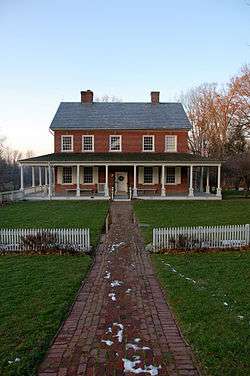Lancaster, Pennsylvania
Lancaster (/ˈlæŋkɪstər/ LANG-kə-stər) is a city located in South Central Pennsylvania which serves as the seat of Pennsylvania's Lancaster County and one of the oldest inland towns in the United States.[3] With a population of 59,322,[4] it ranks eighth in population among Pennsylvania's cities.[5] The Lancaster metropolitan area population is 507,766,[6] making it the 101st largest metropolitan area in the U.S. and second largest in the South Central Pennsylvania area.[6]
Lancaster Lengeschder | |
|---|---|
City | |
| City of Lancaster | |
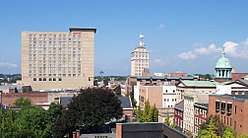 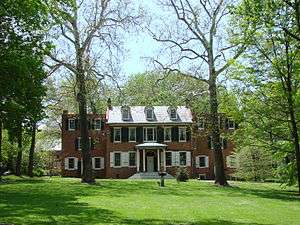 From top, left to right: Lancaster skyline, Soldiers and Sailors Monument, Central Market, Wheatland | |
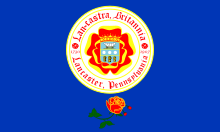 Flag  Seal | |
| Nickname(s): The Red Rose City | |
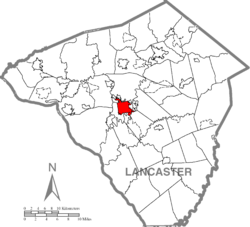 Location in Lancaster County | |
 Lancaster Location in Pennsylvania  Lancaster Lancaster (the United States) | |
| Coordinates (Penn Square): 40°2′23″N 76°18′16″W | |
| Country | United States |
| State | Pennsylvania |
| County | Lancaster |
| Founded | 1729 |
| Incorporated (borough) | 1742 |
| Incorporated (city) | 1818 |
| Founded by | James Hamilton |
| Named for | Lancaster, Lancashire, England |
| Seat | Lancaster County |
| Government | |
| • Type | Strong mayor − council |
| • Mayor | Danene Sorace (D) |
| • City Council | Member List
|
| Area | |
| • City | 7.35 sq mi (19.03 km2) |
| • Land | 7.23 sq mi (18.72 km2) |
| • Water | 0.12 sq mi (0.31 km2) |
| • Metro | 802 sq mi (2,080 km2) |
| Elevation | 368 ft (112 m) |
| Population (2010) | |
| • City | 59,322 |
| • Estimate (2019)[2] | 59,265 |
| • Rank | 8th in Pennsylvania |
| • Density | 8,200.50/sq mi (3,166.09/km2) |
| • Urban | 402,004 |
| • Metro | 507,766 |
| Demonym(s) | Lancastrians |
| Time zone | UTC−5 (EST) |
| • Summer (DST) | UTC−4 (EDT) |
| ZIP Codes | 17573, 17601−17608, 17611, 17622, 17699 |
| Area code(s) | 717 and 223 |
| FIPS code | 42-41216 |
| Website | cityoflancasterpa |
The city's primary industries include healthcare, tourism, public administration, manufacturing, and both professional and semi-professional services. Lancaster is best known for being the hub of Pennsylvania's Amish Country. Lancaster was home to James Buchanan, the nation's 15th president,[7] and to congressman and abolitionist Thaddeus Stevens.[8]
History
Originally called Hickory Town, the city was renamed after the English city of Lancaster by native John Wright. Its symbol, the red rose, is from the House of Lancaster.[9] Lancaster was part of the 1681 Penn's Woods Charter of William Penn, and was laid out by James Hamilton in 1734. It was incorporated as a borough in 1742 and incorporated as a city in 1818.[10]
During the American Revolution, Lancaster was the capital of the United States for one day, on September 27, 1777, after the Continental Congress fled Philadelphia, which had been captured by the British. The revolutionary government then moved still farther away to York, Pennsylvania.[11]
Lancaster was capital of Pennsylvania from 1799 to 1812, after which the capital was moved to Harrisburg.[11]
In 1851, the current Lancaster County Prison was built in the city, styled after Lancaster Castle in England. The prison remains in use, and was used for public hangings until 1912.[12] It replaced a 1737 structure on a different site.
The first long-distance paved road in the United States was the former Philadelphia and Lancaster Turnpike, which connected the cities of Lancaster and Philadelphia. Opened in 1795, the turnpike was paved with stone the whole way, and overlaid with gravel. The sixty-two-mile turnpike cost more than $450,000, a staggering sum for the time. The route followed what is now Pennsylvania Route 340 (also called the "Old Philadelphia Pike") from Lancaster to Thorndale and U.S. Route 30 Business and U.S. Route 30 from Thorndale to Philadelphia.
The city of Lancaster was home to several important figures in American history. Wheatland, the estate of James Buchanan, the fifteenth President of the United States, is one of Lancaster's most popular attractions. Thaddeus Stevens, considered among the most powerful members of the United States House of Representatives, lived in Lancaster as an attorney. Stevens gained notoriety as a Radical Republican and for his abolitionism. The Fulton Opera House in the city was named for Lancaster native Robert Fulton, a renaissance man who created the first fully functional steamboat. All of these individuals have had local schools named after them.
After the American Revolution, the city of Lancaster became an iron-foundry center. Two of the most common products needed by pioneers to settle the Frontier were manufactured in Lancaster: the Conestoga wagon and the Pennsylvania long rifle. The Conestoga wagon was named after the Conestoga River, which runs through the city.[13] The innovative gunsmith William Henry lived in Lancaster and was a U.S. congressman and leader during and after the American Revolution.
In 1803, Meriwether Lewis visited Lancaster to be educated in survey methods by the well-known surveyor Andrew Ellicott. During his visit, Lewis learned to plot latitude and longitude as part of his overall training needed to lead the Lewis and Clark Expedition.[14]
In 1879, Franklin Winfield Woolworth opened his first successful "five and dime" store in the city of Lancaster, the F. W. Woolworth Company.[13]
Lancaster was one of the winning communities for the All-America City award in 2000.[15]
On October 13, 2011, Lancaster's City Council officially recognized September 27 as Capital Day, a holiday recognizing Lancaster's one day as capital of the United States in 1777.
Geography
Lancaster is located at 40°02'23" North, 76°18'16" West (40.039860, −76.304366),[16] and is 368 feet (112 m) above sea level.
The city is located about 34 miles (55 km) southeast of Harrisburg, 70 miles (110 km) west of Philadelphia, 55 miles (89 km) north-northeast of Baltimore and 87 miles (140 km) northeast of Washington, D.C.
The nearest towns and boroughs are Millersville (4.0 miles), Willow Street (4.8 miles), East Petersburg (5.3 miles), Lititz (7.9 miles), Landisville (8.6 miles), Mountville (8.8 miles), Rothsville (8.9 miles), and Leola (8.9 miles).
According to the United States Census Bureau, the city has a total area of 7.4 square miles (19 km2), of which, 7.4 square miles (19 km2) of it is land and 0.14% is water.
Climate
Lancaster has a humid subtropical climate (Köppen climate classification Cfa) with hot or very warm summers. The hottest recorded temperature in the city was 103 °F (39 °C) on July 23, 2011 while the coldest recorded temperature was −16 °F (−27 °C) on January 22, 1984. On average, the city receives 42 inches of precipitation a year. September is the wettest month of the year and February the driest. The snowiest winter on record for Lancaster was the winter of 2009-10 when 72 inches of snow fell and the smallest amount of snow on record was when four inches fell during the winter of 1949–50. The highest recorded January temperature was 77 °F (25 °C) on January 26, 1950 and the coldest July temperature 42 °F (6 °C) on July 4, 1918.
On average, the city receives 203 days of sun a year. The shortest days of the year are between December 18 and December 25, when day length is nine hours and 19 minutes. The sun reaches its lowest point in the sky of 26° between December 11 and December 31. The longest days of the year are June 19 to June 23, reaching 15 hours and one minute. The sun reaches its highest point in the sky of 73° from June 10 to July 2.
| Climate data for Lancaster, Pennsylvania (1981–2010 normals, extremes 1949–present) | |||||||||||||
|---|---|---|---|---|---|---|---|---|---|---|---|---|---|
| Month | Jan | Feb | Mar | Apr | May | Jun | Jul | Aug | Sep | Oct | Nov | Dec | Year |
| Record high °F (°C) | 70 (21) |
76 (24) |
88 (31) |
93 (34) |
99 (37) |
97 (36) |
103 (39) |
101 (38) |
99 (37) |
91 (33) |
86 (30) |
76 (24) |
103 (39) |
| Average high °F (°C) | 38.1 (3.4) |
41.4 (5.2) |
51.0 (10.6) |
62.9 (17.2) |
72.6 (22.6) |
81.0 (27.2) |
85.2 (29.6) |
83.5 (28.6) |
76.0 (24.4) |
64.9 (18.3) |
53.8 (12.1) |
42.1 (5.6) |
62.8 (17.1) |
| Average low °F (°C) | 22.0 (−5.6) |
23.8 (−4.6) |
31.1 (−0.5) |
40.5 (4.7) |
50.0 (10.0) |
59.7 (15.4) |
64.3 (17.9) |
62.6 (17.0) |
54.8 (12.7) |
43.2 (6.2) |
34.6 (1.4) |
26.3 (−3.2) |
42.8 (6.0) |
| Record low °F (°C) | −16 (−27) |
−9 (−23) |
−2 (−19) |
16 (−9) |
28 (−2) |
36 (2) |
46 (8) |
37 (3) |
34 (1) |
23 (−5) |
12 (−11) |
−3 (−19) |
−16 (−27) |
| Average precipitation inches (mm) | 2.88 (73) |
2.47 (63) |
3.27 (83) |
3.38 (86) |
3.89 (99) |
3.94 (100) |
4.50 (114) |
3.20 (81) |
4.56 (116) |
3.85 (98) |
3.60 (91) |
3.27 (83) |
42.81 (1,087) |
| Average snowfall inches (cm) | 5.5 (14) |
7.5 (19) |
1.4 (3.6) |
0.2 (0.51) |
0 (0) |
0 (0) |
0 (0) |
0 (0) |
0 (0) |
0 (0) |
0.4 (1.0) |
3.3 (8.4) |
18.3 (46) |
| Average precipitation days (≥ 0.01 in) | 9.8 | 8.5 | 9.9 | 11.3 | 12.7 | 10.7 | 10.3 | 9.2 | 9.1 | 9.3 | 10.4 | 10.2 | 121.4 |
| Average snowy days (≥ 0.1 in) | 3.0 | 2.1 | 0.8 | 0.1 | 0 | 0 | 0 | 0 | 0 | 0 | 0.2 | 1.3 | 7.5 |
| Source: NOAA[17][18] | |||||||||||||
Demographics
| Historical population | |||
|---|---|---|---|
| Census | Pop. | %± | |
| 1790 | 3,762 | — | |
| 1800 | 4,292 | 14.1% | |
| 1810 | 5,405 | 25.9% | |
| 1820 | 6,633 | 22.7% | |
| 1830 | 7,704 | 16.1% | |
| 1840 | 8,417 | 9.3% | |
| 1850 | 12,369 | 47.0% | |
| 1860 | 17,603 | 42.3% | |
| 1870 | 20,233 | 14.9% | |
| 1880 | 25,769 | 27.4% | |
| 1890 | 32,011 | 24.2% | |
| 1900 | 41,459 | 29.5% | |
| 1910 | 47,227 | 13.9% | |
| 1920 | 53,150 | 12.5% | |
| 1930 | 59,949 | 12.8% | |
| 1940 | 61,345 | 2.3% | |
| 1950 | 63,774 | 4.0% | |
| 1960 | 61,055 | −4.3% | |
| 1970 | 57,690 | −5.5% | |
| 1980 | 54,725 | −5.1% | |
| 1990 | 55,551 | 1.5% | |
| 2000 | 56,348 | 1.4% | |
| 2010 | 59,322 | 5.3% | |
| Est. 2019 | 59,265 | [2] | −0.1% |
| Sources:[19][20][21] | |||
As of the 2010 census, the city was 55.2% White, 16.3% Black or African American, 0.7% Native American, 3.0% Asian, 0.1% Native Hawaiian, and 5.8% were two or more races. 39.3% of the population were of Hispanic or Latino ancestry.[22]
As of the census[20] of 2000, there were 56,348 people, 20,933 households, and 12,162 families residing in the city. The population density was 7,616.5 people per square mile (2,940.0/km²). There were 23,024 housing units at an average density of 3,112.1 per square mile (1,201.3/km²). The racial makeup of the city was 61.55% White, 14.09% African American, 0.44% Native American, 2.46% Asian, 0.08% Pacific Islander, 17.44% from other races, and 3.94% from two or more races. 30.76% of the population were Hispanic or Latino people of any race.
Ethnic groups
The largest ethnic groups in Lancaster as of recent estimates are:[23][24]
- Puerto Rican 29.2%
- German 21.2%
- African American 12.8%
- Irish 8.6%
- English 8.2%
- Italian 4.1%
- Dominican 3.2%
- Polish 2.0%
- Scottish 1.9%
- Mexican 1.8%
- Cuban 1.7%
- West Indian 1.0%
In 2010, 29.2% of Lancaster residents were of Puerto Rican ancestry. The city has the second highest concentration of Puerto Ricans in Pennsylvania after Reading. For this reason, it is sometimes referred to as the "Spanish Rose." Lancaster celebrates its Puerto Rican heritage once every year with the Puerto Rican Festival.[25]
There were 20,933 households, out of which 31.6% had children under the age of 18 living with them, 33.4% were married couples living together, 19.0% had a female householder with no husband present, and 41.9% were non-families. 33.1% of all households were made up of individuals, and 9.9% had someone living alone who was 65 years of age or older. The average household size was 2.52 and the average family size was 3.23.
In the city, the population was spread out, with 27.5% under the age of 18, 13.9% from 18 to 24, 30.5% from 25 to 44, 17.7% from 45 to 64, and 10.5% who were 65 years of age or older. The median age was 30 years. For every 100 females, there were 95.2 males. For every 100 females age 18 and over, there were 91.4 males.
The median income for a household in the city was $29,770, and the median income for a family was $34,623. Males had a median income of $27,833 versus $21,862 for females. The per capita income for the city was $13,955. 21.2% of the population and 17.9% of families were below the poverty line. 29.2% of those under the age of 18 and 12.9% of those 65 and older were living below the poverty line. Poverty in Lancaster is twice the state's average, and public school records list more than 900 children as homeless.[26] Although there are many Amish people from this area, not everyone from Lancaster is Amish, contrary to popular belief.[27]
Economy
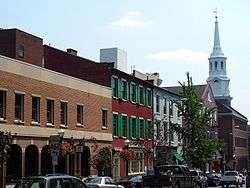
Lancaster City has been in the process of recreating itself, particularly since 2005,[28] with a growth of specialty shops, boutiques, bars, clubs, and reinvestment in downtown institutions and locations. In 2005 the creation of "Gallery Row" solidified the status of Lancaster as an arts destination. The art community continues to thrive and expand.
There are also plans to convert an area of unused polluted industrial grounds (i.e., brownfields), which were once occupied by Armstrong World Industries, into playing fields for Franklin & Marshall College. This action is expected to take up most of the former industrial site. The Northwest Corridor will be developed with funds from Lancaster General Hospital. The hospital plans to create a mixed-use development which will add several city blocks to Lancaster's grid.
Another brownfield site is Burle Business Park, the City's only commercial and industrial park. Devoted to adaptive re-use, this facility originally opened in 1942 as a U.S. Navy electronics research, development and manufacturing plant that was operated by RCA. The Navy facility was purchased after World War II by RCA. Burle Business Park was originally occupied by Burle Industries, the successor company to the RCA New Products Division following the 1986 acquisition of RCA by General Electric Company (GE). The GE acquisition of RCA resulted in the divestiture of this facility and the electronic business, but GE retained certain environmental liabilities that were subdivided into a separate parcel. Burle Industries is a major manufacturer of vacuum tube products, including photomultiplier tubes, power tubes, and imaging tubes. and is the largest U.S. manufacturer of photomultiplier tubes. Burle Industries has completed a voluntary clean-up under the Pennsylvania Land Recycling Program ("Act 2").[29]
Shopping
In addition to Lancaster's boutiques, vintage shops, and art galleries (Gallery Row), Park City Center is the largest enclosed shopping center in South Central Pennsylvania. The mall includes more than 150 stores and is anchored by Boscov's, JCPenney, and Kohl's. Park City opened in September 1971.[30]
Built in 1889, the Lancaster Central Market is the oldest continuously operated farmers market in the United States, and many tourists come to purchase the handmade Amish goods that are not commonly found elsewhere.[31] Central Market is listed with the National Register of Historic Places, and its towers are of the Romanesque Revival style. The market underwent renovations beginning in July 2010.[32]
Lancaster also has two outlet shopping centers, both of which are located in East Lampeter Township on U.S. Route 30. Tanger Outlets is home to about 65 stores. Rockvale Outlets contains over 100 stores and restaurants.[33]
Top employers
According to Lancaster's 2018 Comprehensive Annual Financial Report,[34] the top employers in the city are:
| # | Employer | # of Employees |
|---|---|---|
| 1 | Lancaster General Hospital | 8,802 |
| 2 | Dart Container | 1,961 |
| 3 | County of Lancaster | 1,907 |
| 4 | Nordstrom, Inc. | Data Not Available |
| 5 | Masonic Villages | 1,685 |
| 6 | School District of Lancaster | 1,662 |
| 7 | LSC Communications (formerly RR Donnelley) | Data Not Available |
Government
Lancaster operates under a mayor / council form of government. Danene Sorace is the 43rd mayor of Lancaster city. The City Council is composed of seven members: President James Reichenbach, Vice President Pedro Soto, Chris Ballentine, Faith Craig, Janet Diaz, John Graupera, and Ismail Smith-Wade-El.[35] On November 7, 2017, Councilwoman Danene Sorace was elected Lancaster's 43rd mayor.[36]
The city has a full range of services including public safety, health, housing, parks, streets & highways, Water operations and sewer operations.[37]
Fire Department

The Lancaster City Bureau of Fire has a staff of 75. The City Bureau of Fire operates out of three fire stations, located throughout the city, as well as a maintenance facility. The Bureau operates a fire apparatus fleet of three engines, one truck, and a shift commander, as well as numerous special, support, and reserve units. The Bureau responds to approximately 3,250 emergency calls annually.[38]
Police Department
The city of Lancaster is protected by the City of Lancaster Bureau of Police. Founded in 1865, the Bureau of Police is located at 39 W. Chestnut Street in downtown Lancaster, and consists of approximately 147 sworn officers and 46 civilian employees. The Bureau of Police operates out of twelve sectors, or districts, and operates in four divisions, including Patrol, Criminal Investigative, Administrative Services, and Contracted Services. The Bureau also remains the largest law enforcement agency in Lancaster County.[39][40]
Security camera controversy
Not long after a police officer was wounded in a February 17, 2000 daytime shootout near the center of Lancaster's Penn Square, community residents, law enforcement, and elected officials sought viable solutions to rising crime in downtown. Addressing issues of public safety was a goal when the Lancaster County Crime Commission convened in August 2000. Public meetings and discussions were held over a two-year period. Among the seventeen recommendations in the Crime Commission's 2003 report was to explore the feasibility of a civilian-driven system of security cameras to support law enforcement and first responders.
Largely due to concerns over a government- or police-operated system of cameras, the Lancaster Community Safety Coalition (LCSC) organized and was registered with the Commonwealth of Pennsylvania as a nonprofit in 2004. Its goals included operating a video surveillance system, but it also developed to work on safety by design and community mobilization.[41] Paid LCSC staff are background-checked by the FBI and trained to monitor the network of 164 closed-circuit TV cameras in the city of Lancaster. The community organization is also interested in stimulating economic development in downtown by creating a safe environment.
In 2009, the LCSC's expansion from a 70 to a 165-camera network attracted national attention, including a front-page article in the Los Angeles Times: "Lancaster, Pa., keeps a close eye on itself".[26][42] The article quoted city police chief Keith Sadler as saying, "Years ago, there's no way we could do this... It brings to mind Big Brother, George Orwell and 1984. It's just funny how Americans have softened on these issues."[26]
Prior to the Los Angeles Times article, there had been little public opposition to the CCTV camera system. Data showed it had contributed to the prosecution or prevention of several crimes.[43] However, in response to the national coverage, a small but vocal group of opponents developed, who wanted to turn off the cameras, "possibly for good."[41] The MSNBC commentator Keith Olbermann highlighted the issue in his 'Worst Person in the World' segment, criticizing the citizens for "spying on each other."[42] ABC's Nightline and CBS Evening News also covered the citizen-operated surveillance system.[41]
Politics
While Lancaster County as a whole tilts heavily Republican, the city of Lancaster leans much more Democratic. Registered Democrats held a 13,000 voter registration advantage over registered Republicans in the city as of June 2009.[44] U.S. presidential candidate Barack Obama easily won the city of Lancaster, receiving 76% of the vote during the 2008 presidential election.[45]
Federally, Lancaster is part of Pennsylvania's 11th congressional district, represented by Republican Lloyd Smucker of nearby West Lampeter Township.
The state's senior member of the United States Senate is Democrat Bob Casey, first elected in 2006. The state's junior member of the United States Senate is Republican Pat Toomey, first elected in 2010. The Governor of Pennsylvania is Democrat Tom Wolf of neighboring York County, first elected in 2014. Additionally, the city of Lancaster is the headquarters of the Constitution Party.
Lancaster was home to Democrat James Buchanan, the fifteenth president of the United States. Buchanan arrived in Lancaster in 1809 to practice law. He took up residence near the courthouse on N. Duke Street. In 1848 he purchased Wheatland, a Federal style mansion in the suburbs. He was elected President in 1856.[46]
Neighborhoods


- Cabbage Hill/The Hill (named for the cabbage patches kept by ethnic Germans in this area[47])
- Chestnut Hill
- Downtown/Center City
- Downtown Investment District
- Historic East Side
- Eighth Ward
- Gallery Row/Arts District[48]
- Galebach Ward
- Northwest Corridor
- Penn Square
- Prospect Heights
- Seventh Ward
- Sixth Ward
- Uptown
- West End
- Woodward Hill
Infrastructure
Transportation
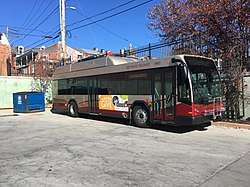
The Red Rose Transit Authority (RRTA) provides local public bus transit to Lancaster City and surrounding areas in Lancaster County. RRTA is headquartered outside the City of Lancaster. The Queen Street Station in downtown Lancaster serves as a transit hub for several RRTA bus routes.[49]
Bieber Transportation Group (formerly Capitol Trailways) formerly provided intercity bus transit from the Lancaster Train and Bus Station to Reading, Norristown, Philadelphia, and New York City to the east, and York to the west; service was discontinued on April 1, 2018.[50][51] Intercity bus service from York and Lancaster to New York City was restored by OurBus in July 2018.[52]
Amtrak also serves the Lancaster Train and Bus Station, located on the northernmost edge of the city at 53 East McGovern Avenue. The Pennsylvanian, with service between Pittsburgh and New York City via Philadelphia, as well as the Keystone Service, which runs from Harrisburg to New York City via Philadelphia, both serve Lancaster.[53] The city is served by the Lancaster Airport, located six miles (10 km) north of downtown and just south of Lititz, with commercial air service by Southern Airways Express to Baltimore and Pittsburgh.
Lancaster is also a hub for automobile traffic, with many major roadways passing through or around the city, including US 30, US 222, PA 283, PA 72, and PA 272.
Utilities
Electricity in Lancaster is provided by PPL Electric Utilities.[54][55] UGI Utilities supplies natural gas to the city.[56][57] The City of Lancaster Water Department provides water service to residents and businesses in the city.[58] The city's Public Works department provides wastewater service to Lancaster, operating the City of Lancaster Advanced Wastewater Treatment Plant which serves the city and surrounding municipalities.[59] Trash and recycling collection is provided by the city's Public Works department.[60]
Historical landmarks
Many of Lancaster's landmarks are significant in local, state, and national history.
- Central Market – built in 1889, it is the oldest continuously run farmers' market in the United States.
- Bethel African Methodist Episcopal Church – built in 1879, the church's congregation aided freedmen migrating to the North for opportunities after the American Civil War. Their congregation had earlier aided fugitive slaves fleeing the South before the war, using their former church as a station on the Underground Railroad.
- Cork Factory Hotel – built in 1865 as Conestoga Cork Works. Later the buildings making up what is known today as Urban Place were home to Armstrong Cork Factory and Kerr Glass Company. Rezoned in 2005, Urban Place has been adapted as 49 loft-style apartments, 115,000 square feet of retail and commercial space, the Cork Factory Hotel, and Cap & Cork Restaurant.
- Fulton Opera House – the oldest continually running theater in the United States, it is one of three theaters designated as National Historic Landmarks (the others are the Walnut Street Theatre in Philadelphia and the Goldenrod Showboat in St. Louis, Missouri).
- Hamilton Watch Complex – former factory and headquarters of the Hamilton Watch Company, which in 1957 sold the world's first battery-powered watch, the Hamilton Electric 500.[61]
- J. P. McCaskey High School – built in 1938 during the Great Depression, it is designed in the Art Deco architectural style.
- Historic St. Mary's Church – built in 1854, this church has served the German-speaking Catholics of Lancaster since 1741.
- Lancaster Arts Hotel – Built in 1881, this building was the Falk and Rosenbaum Tobacco Warehouse. In October 2006, the warehouse reopened after adaptation, as Lancaster's first boutique hotel for the arts. It has 63 guest rooms (including 12 suites); an organic restaurant, John J Jeffries; and an on-site art gallery. It is registered with the Historic Hotels of America.
- Lancaster County Prison – built in 1849, it was styled after the Lancaster Castle in England.
- Rock Ford Plantation – built in 1794, this was the home of General Edward Hand, adjutant general to George Washington during the American Revolutionary War.
- Unitarian Universalist Church of Lancaster, Pennsylvania - built in 1908–1909 in what is now the Historic District of Lancaster, it is unique among the buildings by C. Emlen Urban and contains stained glass by Franz Xaver Zettler (designed by Swiss-American architect Woldemar H. Ritter) and by Charles Connick.
- W. W. Griest Building – listed on the U.S. National Register of Historic Places since June 25, 1999. It was built in 1925 in the Beaux-Arts style using granite, limestone, terra cotta, synthetics, and asphalt. The building is named after William Walton Griest, a former Pennsylvania representative. It is the second-tallest building in the city.
- Wheatland – the historic estate of James Buchanan, the 15th President of the United States.
Art and museums
The city of Lancaster has art, craft and historical museums. The Demuth Museum is located in the former home of the well-known painter Charles Demuth, who had a national reputation in the 20th century. Additional museums include the Lancaster Museum of Art and the Philips Museum of Art on the campus of Franklin & Marshall College. Art students at the state-of-the-art Pennsylvania College of Art and Design present their works at the academy's gallery, which is open to the public. LancasterARTS, a non-profit organization founded in 2002, promotes contemporary arts and crafts.[62]
Lancaster city has a thriving art community. Gallery Row on the 100 block of North Prince St. features a block of art galleries, and the city proper has over 40 galleries and artists' studios. The galleries host a "First Friday" each month, extending their business hours to exhibit new artwork and new artists to the public.
The Lancaster County Quilts and Textile Museum, completed in 2007, celebrates the art of the hand-sewn quilts and other textile items produced by women of the region's Amish and Mennonite communities. The museum was closed in 2011.[63] The Lancaster Mennonite Historical Society Museum and the Heritage Center Museum display artifacts and interpret the region's unique history. Children can have a hands-on experience with educational learning at the Hands-on House, also known as the Children's Museum of Lancaster. Nature and geology-minded visitors can view the exhibits of the Louise Arnold Tanger Arboretum and the North Museum of Natural History and Science.
Stevens and Smith Historic Site is located within the Vine Street lobby of the Lancaster County Convention Center. The site includes the preserved home of U.S. Senator Thaddeus Stevens and his companion Lydia Hamilton Smith. The underground portion of the site includes a recently discovered Underground Railroad feature: a converted water cistern used in the antebellum years to hide fugitive slaves on their way to freedom.[64]
In Lancaster County, the Landis Valley Museum in Manheim Township has exhibits that interpret the county's history and culture, especially as a center of ethnic German Amish and Mennonite culture.
Music and entertainment
There is a rich history of theater and music in Lancaster. The Lancaster Symphony Orchestra has been performing since 1947. The Fulton Opera House is one of the oldest working theaters in the United States. The Ware Center (owned by Millersville University) and The Trust Performing Arts Center (operated by Lancaster Bible College) both regularly host live theater, concerts, and performances. Tellus360 and the Chameleon Club are rock and event venues in downtown Lancaster.
Sports
| Club | League | Sport | Venue | Capacity | Founded | Championships |
|---|---|---|---|---|---|---|
| Lancaster Barnstormers | ALPB | Baseball | Clipper Magazine Stadium | 6,000 | 2005 | (2) 2006, 2014 |
| AFC Lancaster Lions | UPSL | Men's soccer | Lancaster Catholic High School | 500 | 2015 | 0 |
| Lancaster Inferno FC | UWS | Women's soccer | Lancaster Catholic High School | 500 | 2008 | 0 |
Baseball
.png)
The Barnstormers played their inaugural season in 2005, filling Lancaster's 44-year period without professional baseball since the demise of the Red Roses. Their main Atlantic League rival is the Revolution from nearby York.
Lancaster is the hometown of Major League Baseball alumnus Tom Herr. He played for the St. Louis Cardinals for a majority of his career. He also played for the Minnesota Twins, Philadelphia Phillies, New York Mets, and the San Francisco Giants . Herr subsequently coached the Hempfield High School Black Knights baseball team for several years. He also managed the Lancaster Barnstormers in their first season. In 2006, Herr led the club to their first-ever Atlantic League championship over the Bridgeport Bluefish.
Cycling
The Lancaster Bicycle Club hosts an annual Covered Bridge Metric Century bicycle race. In 2010, more than 2,500 riders participated.[65]
The city of Lancaster hosted the Tom Bamford Lancaster Classic, an international, professional bicycle racing event held each June since 1992. It was part of the 2006–2007 UCI America Tour and the 2007 USA Cycling Professional Tour.
Golf
Professional golf is well represented by the Professional Golf Association's Jim Furyk. He placed 4th in the 1998 and 2003 Masters tournament, won the 2003 U.S. Open, placed 4th in the 1997, 1998, and 2006 British Open, and placed 6th in the 1997 PGA championship. Furyk also won the Vardon Trophy in 2006. He is an alumnus of Manheim Township High School, located in the immediate suburb of Manheim Township.
The 2015 U.S. Women's Open was held at the Lancaster Country Club.[66]
Soccer
Lancaster Inferno FC first season was 2008, initially in the Women's Premier Soccer League. They now play in United Women's Soccer, an elite amateur organization. Their colors are navy blue, light blue, black, and orange.
Field hockey
In 2013, USA Field Hockey announced their intentions to move their national training center for the United States women's national field hockey team to Lancaster County. They signed with Spooky Nook Sports through 2022 after searching for many years for a northeastern site.[67]
Amateur sports in Lancaster
Lancaster's suburban area hosts several amateur sports teams. Ice hockey is represented by the Central Penn Panthers, a member of the junior-level Atlantic Metropolitan Hockey League, and both the Lancaster Firebirds, and Regency Panthers youth amateur ice hockey organization of the USA Hockey's Atlantic District.[68][69] American football is represented by the Lancaster Lightning, a member of the semi-professional North American Football League, that plays in nearby Kinzers. A close cousin of American football, rugby, is represented by the Roses Rugby Football Club of the Mid Atlantic Rugby Football Union, of which the Roses RFC were the 2005 champion. Roller derby is represented by the Dutchland Derby Rollers, an all-female roller derby team which plays to raise money for various charities,[70] and is currently ranked #23 in the world by Derby News Network.[71]
Historical Lancaster teams
The Lancaster Red Roses of the Eastern Professional Baseball League are the most well-known of Lancaster's defunct teams. They played from 1906 to 1909, and from 1940 to their last season in 1961. The Red Roses were called the "Lancaster Maroons" from 1896 to 1899 and the "Lancaster Red Sox" in 1932.
The "Lancaster Red Roses" was also the name of a basketball franchise in the Continental Basketball Association (at that time, the Eastern Professional Basketball League) from 1946 to 1949, and from 1953 to 1955. The CBA later hosted another Lancaster team called the Lightning from 1981 to 1985. The Lightning later moved to Rockford, Illinois, where they played until the 2007 season. The Storm of the Eastern Basketball Alliance played from 1997 to 2000, winning the league championship in 1999. The last professional basketball team to call Lancaster home was the Liberty, who played as a member of the now-defunct Global Professional Basketball League in 2009.
Inventions and Firsts
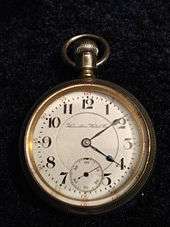
- The first battery-powered watch, the Hamilton Electric 500, was released in 1957 by the Hamilton Watch Company.
- Peeps, an Easter confection shaped as marshmallow chicks covered with yellow sugar, were invented by the Rodda Candy Company of Lancaster in the 1920s. In 1953, Rodda was purchased by Sam Born, the Russian immigrant who invented ice cream "jimmies", and production was moved to Bethlehem, Pennsylvania.
- The Conestoga wagon was first built in Lancaster, used extensively for migrations before the development of the railroad.
- The first Pennsylvania Rifle was created by Martin Meylin in the 1700s.
Education
Education in Lancaster is provided by many private and public institutions. The School District of Lancaster runs the city's public schools. Established in 1836, it is the second oldest school district in Pennsylvania.[72]
The local high school campuses are McCaskey and McCaskey East. Lancaster Catholic High School has a long history in the county; it was founded in 1926. It currently falls under the jurisdiction of the diocese of Harrisburg. With a P-12 enrollment of more than 500 students, Lancaster Country Day School is one of the region's largest independent nonsectarian schools. Founded in 1908 as the Shippen School for Girls, the school became coeducational and relocated from downtown Lancaster to its Hamilton Road address in 1949. La Academia Partnership Charter School, opened in 1998, serves grades 6-12. It is the only public charter school in Lancaster County, and is open to any student residing in the county. Manheim Township School District is a four-year public high school located in Lancaster. It is the only high school in the Manheim Township School District. It is supported by a 7th and 8th grade middle school, a 5th and 6th grade intermediate school, and five elementary schools.
In 2008, Manheim Township High School was named one of the top 505 high schools in the nation by U.S. News & World Report. It is also known for graduating professional golfer Jim Furyk.
On May 13, 2015, Lancaster City was named by GoodCall as the number one best city in the country to be a teacher.[73] The top 10 list was based on average annual teacher salary, available teaching jobs, teaching jobs per capita, high school graduation rates, cost of living and amenities. Data was gathered from the U.S. Census, Indeed.com, the National Center for Education Statistics, and WalkScore.com.
The Lancaster area hosts several colleges and universities, including Consolidated School of Business, Franklin & Marshall College, Lancaster General College of Nursing & Health Sciences, Lancaster Theological Seminary, Lancaster Bible College, Pennsylvania College of Art and Design, Thaddeus Stevens College of Technology, Millersville University of Pennsylvania, Central Pennsylvania College, Elizabethtown College and the Harrisburg Area Community College.
Media
Print
- LNP, the county's predominant newspaper
- La Voz Hispana, the city's Spanish-language edition
- Sunday News, the county's weekly edition
- Fly Magazine, Lancaster City's Downtown Guide
- Fine Living Lancaster, a regional lifestyle magazine
TV
| TV stations | ||||
|---|---|---|---|---|
| Call letters | Channel | Network | Location | Owner |
| WGAL 8 | 8.1 | NBC | Lancaster | Hearst Corporation |
| WGAL–DT2 | 8.2 | MeTV | Lancaster | Hearst Corporation |
| TeleCentro TV | Comcast 949 | Public access | Lancaster | Spanish American Civic Association |
Lancaster is part of the Harrisburg-Lancaster-York market. In addition to WGAL and TeleCentro TV, the city is served by CBS/MyNetworkTV/CW affiliate WHP-TV 21, ABC affiliate WHTM-TV 27, PBS member station WITF-TV 33, and Fox affiliate WPMT 43. WPMT is based in York, while the other major stations are based in Harrisburg.
Radio stations
Nearby cities
References
- "2019 U.S. Gazetteer Files". United States Census Bureau. Retrieved July 28, 2020.
- "Population and Housing Unit Estimates". United States Census Bureau. May 24, 2020. Retrieved May 27, 2020.
- "History of the City of Lancaster". City of Lancaster. Archived from the original on 18 March 2012. Retrieved 21 July 2011.
- "The Most Populous Counties and the Most Populous Cities and Townships in 2010 in Pennsylvania". US Census Bureau. Archived from the original (xls) on 9 April 2011. Retrieved 5 April 2011.
- "GCT-T1-R. Population Estimates (geographies ranked by estimate)". Pennsylvania – Place and County Subdivision. US Census Bureau. Archived from the original on 12 February 2020. Retrieved 31 March 2011.
- "Annual Estimates of the Population of Metropolitan and Micropolitan Statistical Areas: April 1, 2000 to July 1, 2009". 2009 Population Estimates. United States Census Bureau, Population Division. March 23, 2010. Archived from the original (CSV) on October 13, 2013. Retrieved March 29, 2010.
- "James Buchanan's Wheatland--Presidents: A Discover Our Shared Heritage Travel Itinerary". www.nps.gov. Retrieved 2015-12-28.
- "Thaddeus Stevens". History Net: Where History Comes Alive - World & US History Online. Retrieved 2015-12-28.
- "A History of Lancaster, PA". Retrieved 1 July 2016.
- "Lancaster County History". PHMC. Archived from the original on September 8, 2006. Retrieved August 1, 2006.
- City of Lancaster, PA Archived 2011-07-08 at the Wayback Machine
- Lancaster County Prison overview Archived 2009-01-18 at the Wayback Machine
- "Lancaster - Pennsylvania, United States". Retrieved 1 July 2016.
- "Lewis and Clark Expo timeline".
- Archived July 7, 2010, at the Wayback Machine
- "US Gazetteer files: 2010, 2000, and 1990". United States Census Bureau. 2011-02-12. Retrieved 2011-04-23.
- "NowData - NOAA Online Weather Data". National Oceanic and Atmospheric Administration. Retrieved 2015-07-27.
- "Station Name: PA LANCASTER 2NE FLTR PLT". National Oceanic and Atmospheric Administration. Retrieved 2015-07-27.
- "Census of Population and Housing". U.S. Census Bureau. Retrieved 11 December 2013.
- "U.S. Census website". United States Census Bureau. Retrieved 2008-01-31.
- "Incorporated Places and Minor Civil Divisions Datasets: Subcounty Resident Population Estimates: April 1, 2010 to July 1, 2012". Population Estimates. U.S. Census Bureau. Archived from the original on 11 June 2013. Retrieved 11 December 2013.
- "Census 2010: Pennsylvania - USATODAY.com".
- "population". Lancaster Online. Archived from the original on February 14, 2020. Retrieved September 18, 2006.
- "population2". Lancaster Online. Archived from the original on February 14, 2020. Retrieved September 18, 2006.
- "Puerto Rican Festival". Lancaster Online. Archived from the original on November 9, 2006. Retrieved September 18, 2006.
- Drogin, Bob (21 June 2009). "Lancaster, Pa., keeps a close eye on itself". Los Angeles Times. Retrieved 1 July 2016.
- Stuhldreher, Tim. "Plain & Growing: Amish population doubles every 20 years, now totaling 300,000 in US and Canada". Lancaster Online. LNP Media Group. Retrieved 15 July 2018.
- "Opinion | Where American Politics Can Still Work: From the Bottom Up". Retrieved 2018-07-04.
- PADEP, appendices of Act 2 annual reports
- Schuyler, David. A City Transformed: Redevelopment, Race, and Suburbanization in Lancaster, Pennsylvania. ISBN 9780271045238. Retrieved 30 July 2012.
- "History of Central Market". LancasterPA.net. Archived from the original on February 11, 2006. Retrieved May 30, 2006.
- "Behind The Scenes At Central Market". WGAL-TV News Broadcast (Video). 5 November 2010. Archived from the original on 17 July 2011. Retrieved 9 December 2010.
- Fodor's Philadelphia and the Pennsylvania Dutch Country. Fodor's. 2007. p. 234. ISBN 978-1-4000-1822-2. Retrieved 26 January 2011.
- City of Lancaster CAFR
- . Lancaster City Council Members. Retrieved on 7 November 2017.
- Election Map: Who Won the Race for Lancaster Mayor. Lancaster Online. Retrieved on 8 November 2017.
- Lancaster City Assets & Resources. Lancaster City Living. Retrieved on 23 July 2013.
- "Fire". City of Lancaster, Pennsylvania. Retrieved June 21, 2015.
- Archived June 12, 2012, at the Wayback Machine
- A Brief History of the Lancaster Bureau of Police | Lancaster City Bureau of Police. Lancasterpolice.com (2013-06-22). Retrieved on 2013-07-23.
- "Lancaster's candid cameras: Who funds them and what the controversial videos show" Archived 2009-08-19 at the Wayback Machine
- "Keeping watch on the city's cameras" Archived 2009-06-27 at the Wayback Machine, Lancaster Online
- "Results of CCTV" Archived 2011-05-07 at the Wayback Machine, Lancaster Online, 2009
- Harris, Bernard (2009-06-26). "It's official: Smithgall running for mayor again". Lancaster New Era. Archived from the original on 2009-06-29. Retrieved 2009-10-31.
- "Smithgall 'probably' running for mayor again". Lancaster New Era. 2009-05-21. Archived from the original on 2009-06-05. Retrieved 2009-10-31.
- Donovan, Sandra (2005). James Buchanan. Lerner Publications. p. 21. ISBN 978-0-8225-1399-5.
- Cabbage Hill. Lancaster City Living. Retrieved on 2013-07-23.
- "Visit Lancaster City, Pennsylvania". Retrieved 1 July 2016.
- "Transit Center". Red Rose Transit Authority. Retrieved September 18, 2019.
- "Daily Bus Service to Philadelphia, PA". Bieber Transportation Group. January 8, 2017. Retrieved February 6, 2017.
- "Daily Bus Service to New York City, NY". Bieber Transportation Group. January 8, 2017. Archived from the original on February 8, 2017. Retrieved February 6, 2017.
- "New Partnership Restores Daily Bus Service". Lancaster Online. July 2018. Retrieved November 1, 2018.
- http://www.amtrak.com/servlet/ContentServer?c=am2Station&pagename=am%2Fam2Station%2FStation_Page&cid=1229726268117 amtrak.com
- "Service Area". PPL Electric Utilities. Retrieved August 20, 2017.
- "General Tariff" (PDF). PPL Electric Utilities. June 20, 2017. p. 4. Retrieved August 20, 2017.
- "Geographic Footprint". UGI. Retrieved October 4, 2017.
- "Gas Tariff" (PDF). UGI Utilities. July 7, 2017. pp. 5–6. Retrieved October 10, 2017.
- "Water". City of Lancaster. Retrieved September 9, 2018.
- "Wastewater". City of Lancaster. Retrieved September 9, 2018.
- "Solid Waste & Recycling". City of Lancaster. Retrieved September 9, 2018.
- "Jan. 3, 1957: Debut of the Electric Watch, a Space Age Marvel". Wired. January 3, 2008.
- LancasterARTS cultivating an environment where arts can flourish in Lancaster, PA. Lancasterarts.com. Retrieved on 2013-07-23.
- "Lancaster Quilt & Textile Museum will fold". Retrieved 28 October 2018.
- "Thaddeus Stevens & Lydia Hamilton Smith Historic Site". LancasterHistory.org. Retrieved 15 April 2017.
- Lancaster Bicycle Club - Bike Club - Lancaster County, PA Archived 2010-07-13 at the Wayback Machine. Lancasterbikeclub.org (2010-08-15). Retrieved on 2013-07-23.
- Lancaster Country Club to host the U.S. Women's Open Archived 2009-02-20 at the Wayback Machine
- USA Field Hockey moving base to Lancaster Archived 2013-02-06 at the Wayback Machine. Spooky Nook Sports (2013-01-22). Retrieved on 2013-07-23.
- "Lancaster County Youth Hockey League powered by GOALLINE.ca". Retrieved 1 July 2016.
- "Central Penn Panthers". Archived from the original on 27 August 2016. Retrieved 1 July 2016.
- "Home - Dutchland Derby Rollers". Retrieved 1 July 2016.
- Derby News Network Archived 2011-10-20 at the Wayback Machine
- "Lancaster: Education and Research - Elementary and Secondary Schools, Colleges and Universities". Retrieved 1 July 2016.
- "2015's Best Places to Be a Teacher in the U.S. - GoodCall DataCenter". 13 May 2015. Retrieved 1 July 2016.
Further reading
- Alexander, Brian (2017). Glass House: The 1% Economy and the Shattering of the All-American Town. New York: St. Martin's Press. ISBN 9781250085801. OCLC 947146034.
- Interview with the author: "'Glass House' Chronicles the Sharp Decline of an All-American Factory Town". Fresh Air. NPR. February 6, 2017. Retrieved February 7, 2017.
- Lottie M. Bausman, A Bibliography of Lancaster County, Pennsylvania, 1745–1912. Philadelphia: Pennsylvania Federation of Historical Societies, 1917.
- Frank Ried Diffenderffer, The Early Settlement and Population of Lancaster County and City. Lancaster, PA: The New Era, 1905.
- H. M. J. Klein, Lancaster's Golden Century, 1821–1921: A Chronicle of Men and Women Who Planned and Toiled to Build a City Strong and Beautiful. Lancaster, PA: Hager and Brother, 1921.
- The Lancaster Farmer: A Monthly Newspaper. Vol. 1 (1869) | Vol. 2 (1870) | Vol. 3 (1871) | Vol. 4 (1872) | Vol. 5 (1873) | Vol. 6 (1874) | Vol. 7 (1875) | Vol. 8 (1876) | Vol. 9 (1877) | Vol. 10 (1878) | Vol. 11 (1879) | Vol. 12 (1880) | Vol. 13 (1881) | Vol. 14 (1882) | Vol. 15 (1883) | Vol. 16 (1885)
- Dave Pidgeon, "Battle Over City Project Moves to Courtroom", Intelligencer Journal (Lancaster, PA), July 13, 2006.
- William Riddle, One Hundred And Fifty Years of School History in Lancaster, Pennsylvania. Lancaster, PA: William Riddle, 1905.
- Israel Daniel Rupp, History of Lancaster and York Counties. n.c.: n.p., 1845.
External links
| Wikivoyage has a travel guide for Lancaster, PA. |
- Official website
- Official Lancaster city events website
- Official Tourism Bureau: Discover Lancaster website
- PA Dutch Country Welcome Center website
- Lancaster, Pennsylvania at Curlie
| Preceded by Philadelphia |
Capital of the United States of America 1777 |
Succeeded by York |
